Mental illness: symptoms, types, and treatments
Table of content
- What is mental illness?
- How common is mental illness?
- What are the symptoms of mental illness?
- What are the causes of mental illness?
- What are the risk factors of mental Illness?
- What negative effects can untreated mental illness have?
- What are the different types of mental illness?
- 1. Anxiety disorders
- 2. Depression
- 3. Bipolar disorder
- 4. Post-traumatic stress disorder (PTSD)
- 5. Schizophrenia
- 6. Eating disorders
- 7. Disruptive behavior and dissocial disorders
- 8. Neurodevelopmental disorders
- Is mental illness genetic?
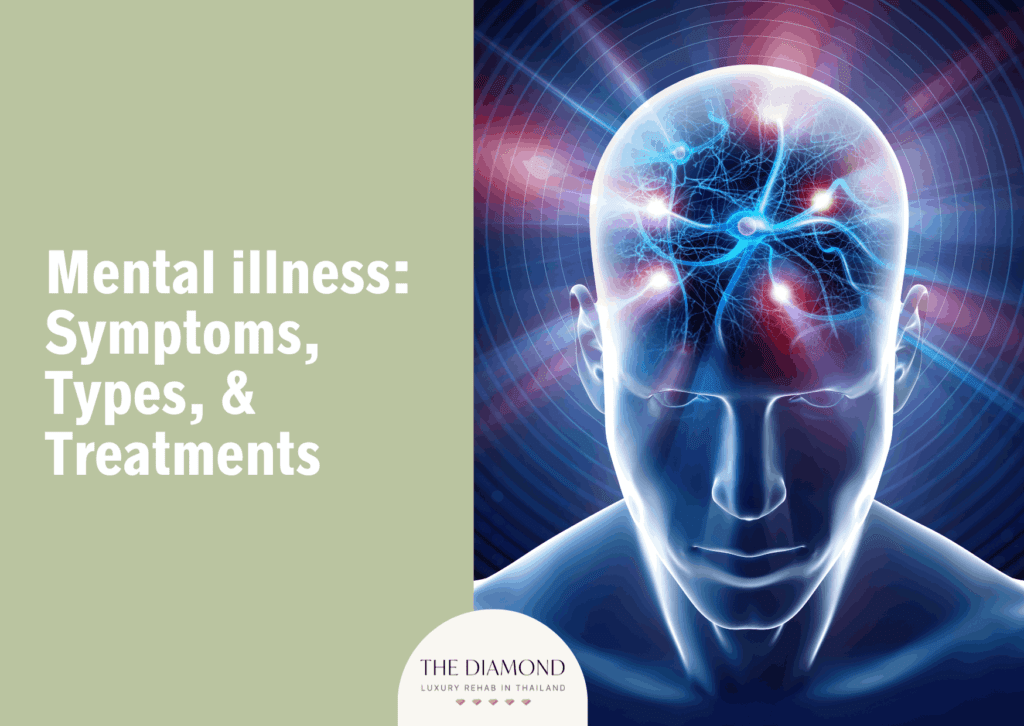
Mental illness is a term that refers to all conditions that affect how a person thinks, feels, or behaves. These conditions have a major impact on an individual’s functioning in society and their quality of life.
Symptoms of mental illness typically include persistent sadness, extreme worry, fear, social withdrawal, problems with concentration, problems with sleeping patterns, hallucinations, and delusions.
Types of mental illness include anxiety disorders, depression, bipolar disorder, post-traumatic stress disorder, schizophrenia, eating disorders, disruptive behavior and dissocial disorders, and neurodevelopmental disorders.
Treatments for mental illness include therapy, medications, brain stimulation, addiction treatment, and hospital stay. The specific treatment depends on the severity of the mental illness. Most of the time, a combination of different approaches works best.
What is mental illness?
Mental illness is defined as any condition that affects a person’s thinking, behavior, mood, or feeling. Otherwise known as a psychiatric disorder, mental illness causes significant distress and problems functioning in work, social, or family activities.
The history of mental illness is possibly as old as mankind itself, as the earliest known record of psychiatric disorder traces back to 1100 B.C. China. In traditional Chinese medicine, physicians believed that demonic possessions played a role in mental illness. Similar was the situation in ancient Mesopotamia, where mental illnesses were believed to be caused by specific deities.
Mental illnesses were mentioned in ancient Egypt too. More precisely, Ebers papyrus (dating to cca 1550 B.C.) described states of attention, concentration, and emotional distress in the mind or heart. Years later, it was deciphered that these states were melancholy and hysteria.
When it comes to ancient India, mental illness reflected abstract metaphysical entities, sorcery, witchcraft, and supernatural agents. They believed that disrespect toward gods caused these disorders. Other potential cases of mental illness in ancient India included inadequate diet, faulty bodily activity, and mental shock.
In ancient Greece and Rome, mental illness wasn’t an uncommon subject. For example, Socrates admitted to experiencing symptoms that are known now as hallucinations, whereas Pythagoras heard voices. Hippocrates was the one who classified psychiatric disorders such as mania, melancholia, and paranoia.
Although mental illnesses were present in prehistoric times, it wasn’t until 1883 that Emil Krapelin, a German psychiatrist, published a comprehensive system of psychological disorders that focused on a pattern of symptoms with underlying physiological causes. After that, various clinicians suggested there must be a classification system for these disorders.
These efforts paved the way for the first Diagnostic and Statistical Manual of Mental Disorders (DSM) by the American Psychiatric Association in 1952. That being said, diagnostic validity and reliability weren’t established until several decades later.
Over the next decades, scientists and psychiatrists carried out extensive research to learn as much as possible about mental illnesses, their causes, symptoms, comorbidities, mechanisms of action, and treatments. Numerous studies are still ongoing as society finally starts to lose the stigma surrounding mental illness.

How common is mental illness?
Mental illness is very common, with a 2022 fact sheet titled, “Mental disorders” from the World Health Organization (WHO) reporting that one in eight people in the world had a psychiatric disorder in 2019. More precisely, more than 970 million people worldwide are living with a mental illness. Depression and anxiety were the most prevalent conditions.
Furthermore, according to the Centers for Disease Control and Prevention (CDC), one in five Americans develop a psychiatric disorder in a given year. The same report found that more than one in five youth (ages 13 to 18) have suffered from a severely debilitating mental illness, either presently or at some point in their lives. Severe mental illnesses, including major depression, schizophrenia, and bipolar disorder, affect approximately one in every 25 adults in the United States.
An article titled, “Mental Illness” last updated in March 2023 by the National Institute of Mental Health reported that at a projected count of 57.8 million in 2021, the prevalence of mental illness among U.S. adults is greater than one in every five.
During the same period, the estimated number of adults aged 18 or older with any mental illness (AMI) in the United States was 57.8 million. This number accounted for 22.8% of the total adult population in the United States.
Females exhibited a higher prevalence of AMI (27.2%) in comparison to males (18.1%). The prevalence of AMI was greatest among young adults aged 18 to 25 (33.7%), as opposed to those aged 26 to 49 (28.1%) and 50 and older (15.0%).
A publication titled, “Mental Health By the Numbers” last updated in April 2023 by the National Alliance on Mental Illness reported that in 2016, 16.5% of young Americans aged 6 to 17 had a mental health disorder, thus accounting for 7.7 million people.
What are the symptoms of mental illness?
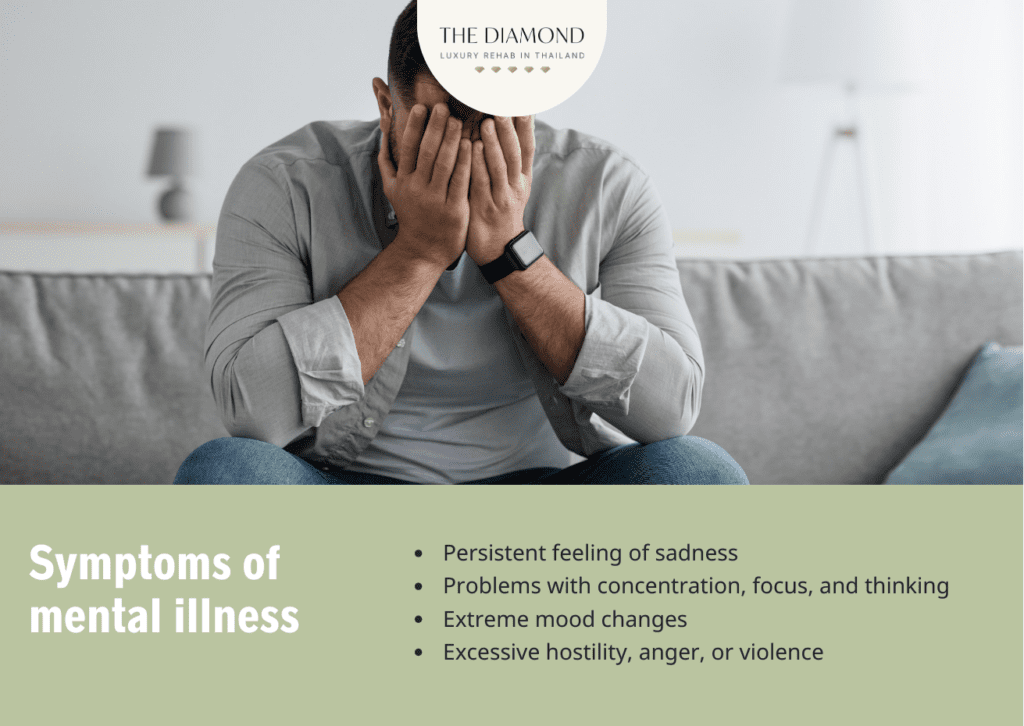
Symptoms of mental illness vary from one condition to another. The most common symptoms of mental illness are listed below:
- Persistent feeling of sadness: Being sad from time to time isn’t a source of concern, but the persistent or chronic feeling of sadness indicates the existence of a mental illness.
- Problems with concentration, focus, and thinking: A person with mental illness often struggles to complete a task at hand due to impaired focus and concentration, their problem-solving and decision-making skills suffer as well.
- Extreme mood changes: Mental illnesses are strongly associated with severe mood oscillations, a person is likely to go from euphoric to depressed quickly.
- Excessive hostility, anger, or violence: Certain persons with mental illnesses express erratic behaviors that put them and others in danger.
- Extreme feelings of guilt, fear, and worries: A person with mental illness constantly experiences intense feelings of fear, guilt, and worry, even if the subject of that feeling doesn’t require that reaction.
- Social withdrawal: Avoiding family and spending time with friends, colleagues, etc.
- Inability to cope with stress and daily problems: Mental illness often takes away a person’s ability to handle stress and other problems or situations they face during the day.
- Delusions (detachment from reality), hallucinations, and paranoia: Most severe forms of mental illness manifest themselves through the distorted perception of reality.
- Problems sleeping, low energy, tiredness: Mental illness causes insomnia, but in certain cases, a person sleeps through all day.
- Lack of empathy: A person with mental health illness finds it difficult to understand other people and how they feel i.e. they’re not able to relate to others.
- Substance abuse: Mental illness manifests itself through heavy alcohol drinking and substance abuse.
- Changes in sex drive: Certain people with mental illnesses have reduced sex drive while others have strongly enhanced libido.
- Changes in eating habits: Eating too much or almost nothing at all
- Suicidal thoughts and tendencies: The most severe symptom of a mental illness, a person contemplates suicide and even goes so far as to try and do so.
What are the causes of mental illness?

The causes of mental illness are intricate and multifaceted, frequently originating from a variety of factors. The causes of mental illness are listed below:
- Genetics: Inherited traits such as changes in certain genes contribute to the development of mental illness.
- Brain chemistry: Impaired neural networks involving neurotransmitters and chemicals that carry signals to other areas of the brain and body. The changes in the function of nerve receptors and systems contribute to the formation of a psychiatric disorder.
- Environmental exposures prior to birth: Being exposed to environmental toxins, inflammatory conditions, drugs, and alcohol while still in the womb is another contributor to the development of a mental illness.
What are the risk factors of mental Illness?
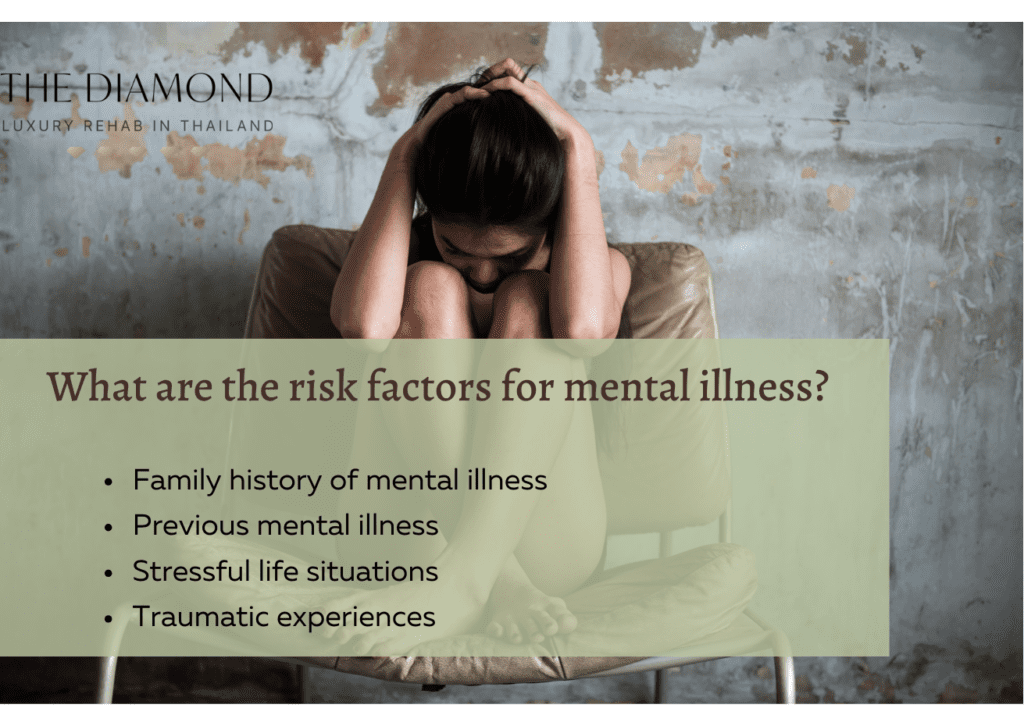
Risk factors for mental illness encompass a variety of factors that raise the chance of getting a mental health condition. The risk factors for mental illness are listed below:
- Family history of mental illness: A person is more likely to develop the mental illness if their blood relative has it as well.
- Previous mental illness: People with a personal history of mental illness are more susceptible to developing a psychiatric disorder.
- Stressful life situations: Going through tough times in life such as divorce, breakups, financial problems, or a loved one’s death increases the risk of mental illness.
- Traumatic experiences: Trauma is a major risk factor for mental illness, especially when the traumatic event happened in childhood. However, adults who go through trauma are just as susceptible to psychiatric conditions.
- Medical condition: Having a chronic medical condition such as diabetes or any serious disease takes its toll on a person’s mental health.
- Traumatic brain injury (TBI): Persons who have sustained TBI due to a violent blow to the head or other reasons are more likely to develop a mental health disorder.
- Substance abuse or addiction: People with addiction to alcohol or drugs are more likely to have a mental illness too, in many cases, they have comorbidities (the existence of two conditions at the same time), but in certain situations, one causes the other. For example, mental illness contributes to addiction and vice versa.
- Lack of healthy relationships: Unhealthy relationships or not having good friends are likely to lead to loneliness, increasing the risk of mental illness.
- Personality factors: Perfectionists, people with low self-esteem, isolated introverts, dramatists, overachievers, and persons who worry too much are more prone to mental illness.
What negative effects can untreated mental illness have?
Untreated mental illness can have short- and long-term effects. Short-term effects of unmanaged mental health disorders include alienation from peers due to perceived unattractive behaviors or personality traits.
Other short-term effects include anger, sadness, fear, and feeling of helplessness, which are particularly emphasized when a person doesn’t know or understand what’s going on. Plus, some patients experience physical symptoms such as increased blood pressure, heart palpitations, breathing problems, dizziness, fatigue, and muscle aches.
Long-term effects of untreated mental illness include insomnia, reduced libido, chronic irritability and fatigue, unhappiness, and dissatisfaction with life. Other long-term effects include relationship problems, family conflicts, financial and legal problems, homelessness, poverty, addiction, self-harm, and a weakened immune system. People with unmanaged mental health disorders additionally tend to develop health problems such as heart disease.
What are the different types of mental illness?
Different types of mental illness pertain to the wide array of psychiatric conditions influencing people’s feelings, ideas, actions, and general way of living. The different types of mental illness are listed in the table below:
| Types of Mental Illnesses |
| Anxiety Disorders |
| Depression |
| Bipolar Disorder |
| Post-Traumatic Stress Disorder (PTSD) |
| Schizophrenia |
| Eating Disorders |
| Disruptive behaviour and dissocial disorders |
| Neurodevelopmental disorders |
1. Anxiety disorders
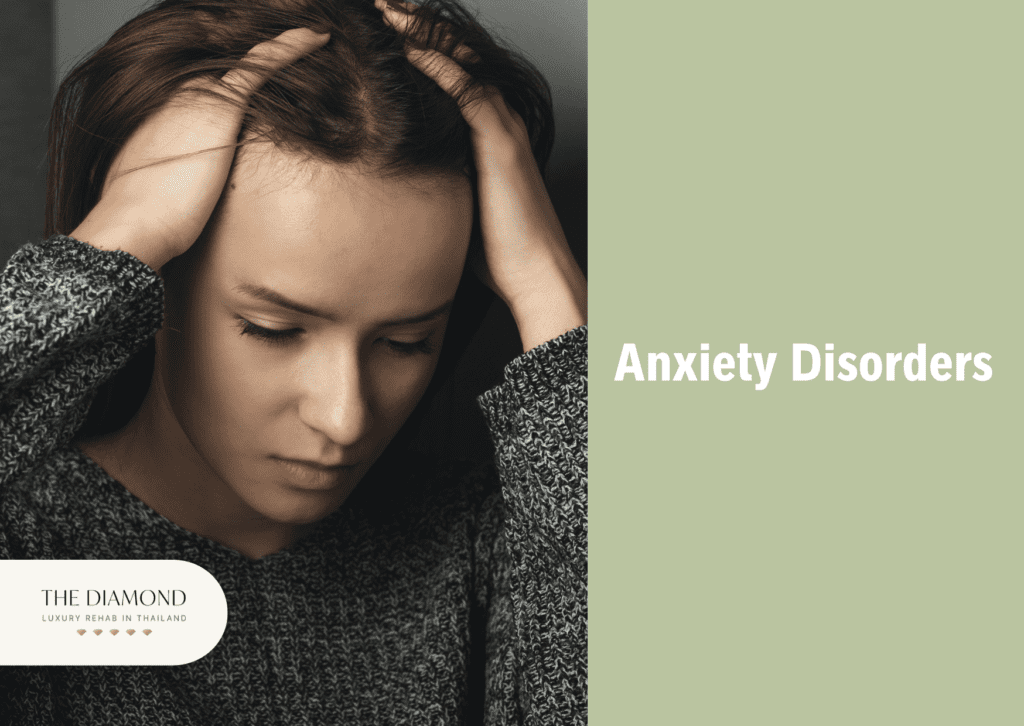
Anxiety disorders are mental health illnesses that cause constant and overwhelming anxiety, fear, panic, or worry. There are different types of anxiety disorders, including generalized anxiety disorder (GAD), panic disorder, social anxiety disorder, specific phobias, separation anxiety, agoraphobia, selective mutism, and medication-induced anxiety disorder.
The exact signs and symptoms of anxiety disorders depend on each condition, but in most cases, they include severe nervousness and restlessness or tension, hyperventilation, impending doom feeling, sweating, trembling, and increased heart rate.
Other symptoms include weakness, difficulty concentrating on anything but a source of worry, difficulty sleeping, gastrointestinal (GI) problems, a strong urge to avoid triggers of anxiety, and difficulty controlling fear, nervousness, or worry.
It’s not entirely clear what causes anxiety, but several factors are potentially involved, including genetics, stress buildup, and traumatic events. Having another mental health condition increases the risk of developing anxiety as well.
When left unmanaged, anxiety disorders cause or contribute to a wide range of effects. These include depression, addiction, insomnia, poor quality of life, social isolation, chronic pain, headaches, digestive problems, complications at work or school, and suicidal ideation.
2. Depression

Depression is a common mental health problem indicated by low mood and loss of interest in activities. The condition interferes with a person’s quality of life. Otherwise known as major depressive disorder or major depression, it affects how people think, feel, and behave.
Symptoms of depression include feelings of helplessness, hopelessness, worthlessness, irritable behavior over small matters, loss of interest in activities once enjoyed, social withdrawal, and sleep disturbances.
Other symptoms include fatigue, appetite changes, restlessness, slowed thinking, trouble thinking and concentrating, unexplained physical problems such as headaches or back pain, and recurrent suicidal thoughts.
While the exact cause of depression is generally unknown, it is likely to occur due to several factors. In most cases, a combination of different causes paves the way to depression. These include physical changes in the brain, changes in function and effect of neurotransmitters, hormone changes, and inherited traits.
As a serious mental health disorder, depression takes its toll on a person’s quality of life and family dynamics. When left untreated, it causes effects such as overweight or obesity, physical illness, substance abuse, relationship/family difficulties, anxiety, social withdrawal, self-harm, premature death due to medical conditions, and suicidal feelings or attempts.
3. Bipolar disorder
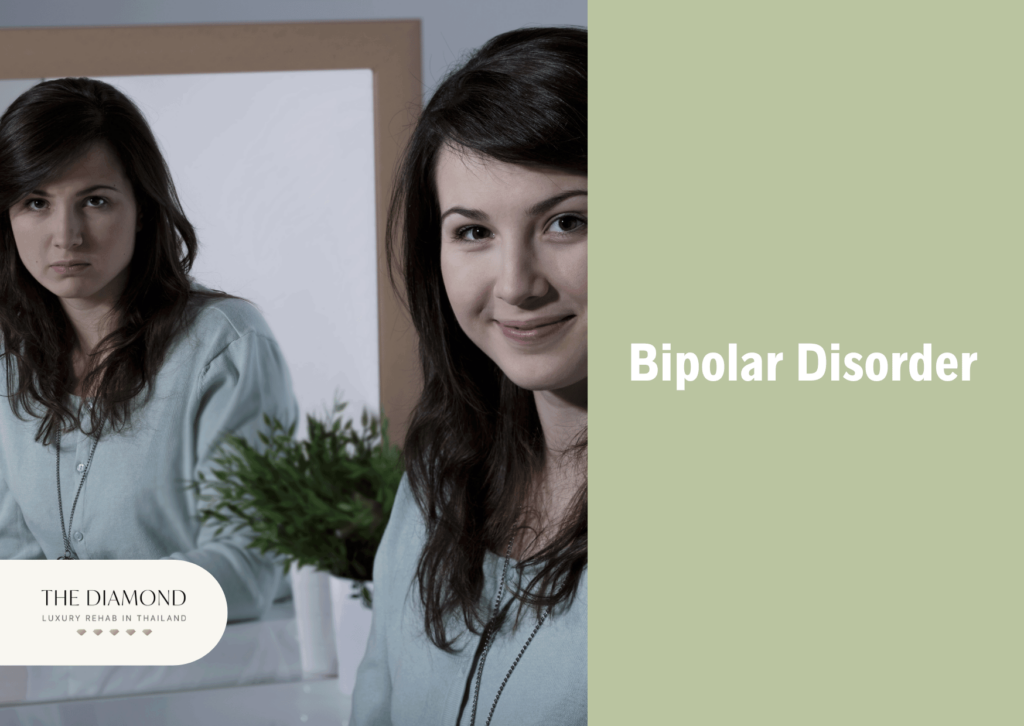
Bipolar disorder is a chronic mood disorder that causes intense changes in mood, behavior, and energy levels. People with bipolar disorder go through emotional highs and euphoria (mania) to severe lows (depression).
These intense changes in mood strongly affect a person’s behavior, sleep patterns, and ability to think. The frequency of episodes varies from one person to another. Certain people experience episodes of mood changes frequently, whereas others rarely.
Not all cases of bipolar disorder are the same. There are four types of this disorder such as bipolar I disorder, bipolar II disorder, cyclothymic disorder, and other types. Bipolar I disorder is indicated by at least one episode of mania that is preceded or followed by depression. In certain instances, mania causes psychosis or detachment from reality.
In bipolar II disorder, a person has at least one episode of depression or hypomania but has never had a manic episode. Cyclothymic disorder refers to having the disorder for at least two years, during which a person experienced several hypomanic or depressive episodes.
Symptoms of mania in bipolar disorder include abnormally jumpy or upbeat behavior, increased energy levels and activity, euphoria, reduced need for sleep, unusual talkativeness, poor decision-making, and being easily distracted.
Depressive episodes manifest themselves through the same depression symptoms mentioned above.
The most likely cause of bipolar disorder is a combination of biological differences and genetics. Patients with bipolar disorder tend to have physical changes in the brain, and the condition involves genetic components too. A person is more likely to have bipolar disorder if their first-degree relative has it.
When left untreated, bipolar disorder causes effects such as poor work/school performance, substance abuse, damaged relationships, legal or financial difficulties, and suicide. The condition additionally co-occurs with anxiety, ADHD, eating disorders, and physical health conditions such as heart disease or thyroid problems.
4. Post-traumatic stress disorder (PTSD)

Post-traumatic stress disorder (PTSD) is a type of anxiety disorder triggered by witnessing or experiencing a terrifying event. Traumatic events are difficult for everyone. While it’s not easy to cope with them, numerous people get better with time, but others do not.
If the symptoms worsen to the point that they interfere with a person’s life and last for months or years, it potentially indicates the presence of PTSD.
Symptoms of post-traumatic stress disorder begin within one month after the terrifying event. Certain people, however, develop symptoms of PTSD years later. Symptoms of this condition are divided into intrusive memories, avoidance, negative changes in thinking and mood, and changes in physical or emotional reactions.
Intrusive memories manifest themselves as recurrent, unwanted, and distressing memories of the traumatic event. People experience flashbacks, nightmares, and emotional or physical reactions to something that reminds them of the traumatic event.
Avoidance is indicated by symptoms such as attempting to avoid talking or thinking about a traumatic event as well as avoiding places, people, and activities that remind a person of the tarrying experience.
Symptoms of negative changes in thinking and mood include hopelessness, emotional numbness, lack of interest in activities once enjoyed, memory problems, negative thoughts about yourself, relationship problems, and detachment from friends and family.
Finally, symptoms of changes in physical or emotional reactions include being easily frightened, difficulty sleeping, always looking out for danger, self-destructive behaviors such as driving too fast, poor concentration, angry outbursts, and overwhelming feelings of shame and guilt.
Causes of PTSD are stressful experiences, including the severity and amount of trauma, inherited mental health risks, a person’s temperament, and how the brain regulates chemicals released during stress. A combination of these causes paves the way for PTSD.
When left untreated, PTSD causes effects such as eating disorders, anxiety, depression, addiction, and suicidal thoughts and tendencies.
5. Schizophrenia
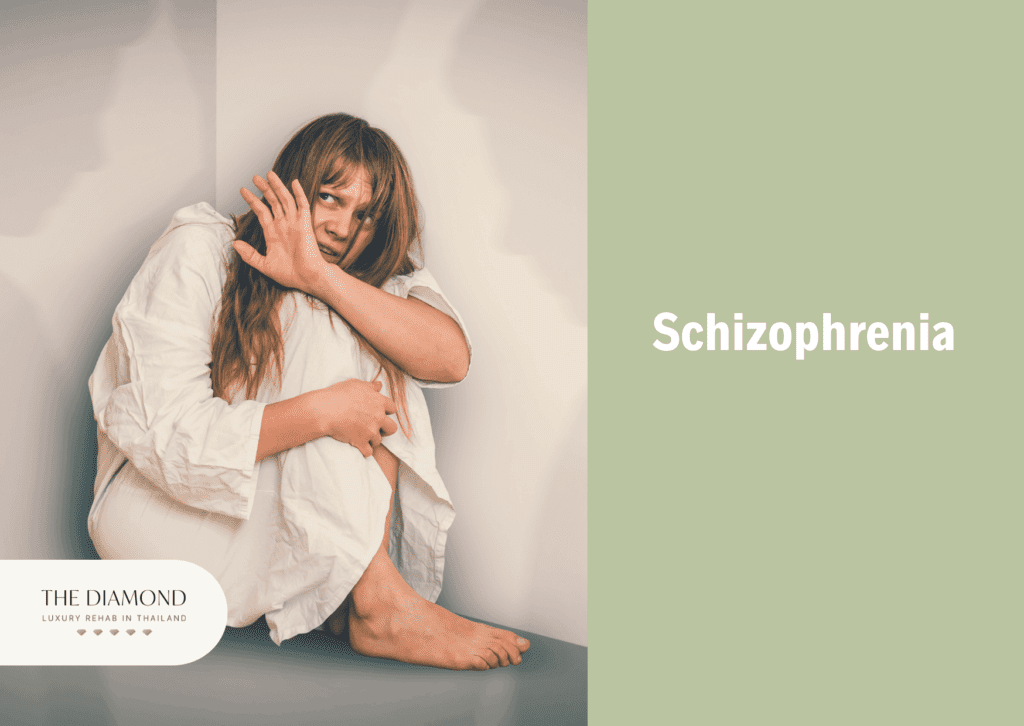
Schizophrenia is a serious mental health illness that affects the way a person perceives reality. A common misconception is that people with schizophrenia have multiple personalities. A person with schizophrenia has hallucinations and delusions, meaning they perceive reality differently, but they do not have multiple personalities like individuals with multiple personality disorder (dissociative identity disorder). Schizophrenia tends to be disabling because disordered thinking leads to problems with behavior and daily functioning.
Signs and symptoms of schizophrenia usually include delusions (false beliefs not based in reality), hallucinations (usually hearing voices), disorganized thinking and speech, and abnormal or disorganized motor behavior such as unpredictable agitation.
A patient with schizophrenia additionally neglects their hygiene, loses interest in everyday activities, isolates themselves from friends and family, and lacks emotion or the ability to feel pleasure.
A combination of changes in brain chemistry, genetics, and environment is likely the main cause of schizophrenia. Patients with schizophrenia have problems with the neurotransmitters dopamine and glutamate. Compared to healthy individuals, they have differences in brain structure and central nervous system.
When left untreated, schizophrenia causes devastating effects such as anxiety and obsessive-compulsive disorder (OCD), depression, addiction, social isolation, financial problems, homelessness, inability to attend school or work, aggressive behavior, and suicidal thoughts and attempts.
6. Eating disorders

Eating disorders are mental health illnesses indicated by abnormal eating behaviors that adversely affect a person’s psychological and physiological health. In most cases, eating disorders include focusing too much on weight and body image.
People with eating disorders are often not satisfied with their appearance, so they adopt unhealthy eating habits in order to achieve their target weight or look. These disorders usually begin in adolescence or young adult years, but people develop them later in life too.
Symptoms of eating disorders depend on the specific type of the condition. For example, people with anorexia nervosa excessively limit calorie intake or adhere to other methods to lose weight. These efforts include over-exercising, vomiting after eating and using laxatives. Anorexia is a life-threatening eating disorder where patients tend to have abnormally low body weight.
Bulimia nervosa, a potentially life-threatening disorder, manifests itself through episodes of binging and purging. In other words, a person eats abnormal amounts of food and then purposely vomits.
Symptoms of binge eating disorder include a lack of control over how much a person eats. Persons with this eating disorder tend to eat too much too quickly and feel guilty or ashamed afterward.
Yet another eating disorder, rumination disorder, manifests itself through repeated and persistent food regurgitation after eating. This happens without nausea and isn’t associated with other eating disorders.
Certain people have avoidant or restrictive food intake disorder, whose main symptom is failing to consume sufficient amounts of nutrients during the day due to a lack of interest in eating. Others tend to avoid foods with certain colors, textures, tastes, or smells.
The causes of eating disorders are the same as those of other mental illnesses. They are genetics and biology as well as the psychological or emotional health of a patient. Several patients have emotional problems that contribute to the development of unhealthy and dangerous eating habits.
The effects of eating disorders tend to be severe. They range from serious health problems, depression, anxiety, and addiction to problems at school and work, impaired growth and development, social and relationship issues, suicidal behaviors, and death.
7. Disruptive behavior and dissocial disorders
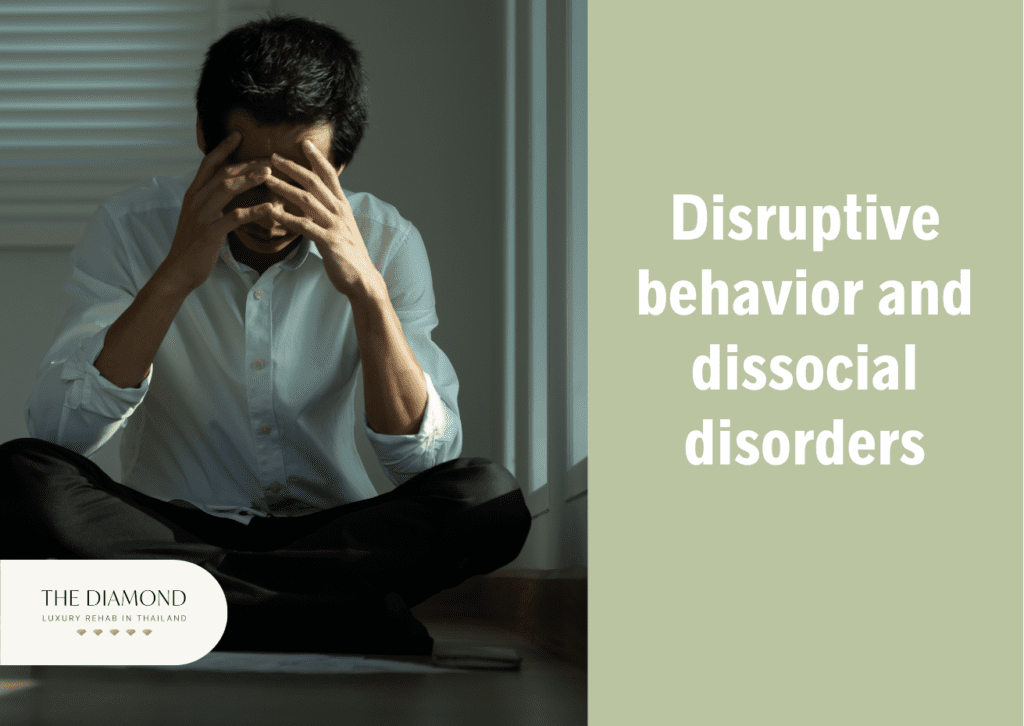
Disruptive behavior disorder (DBD) is a cluster of disorders wherein children and adolescents experience difficulties controlling their emotions and behaviors. The most common types of DBD are oppositional defiant disorder, intermittent explosive disorder, and conduct disorder.
Symptoms depend on the type of DBD. They usually include frequent temper tantrums, excessive arguments with adults, refusing to follow the rules, purposely behaving to upset others, blaming others for mistakes, becoming easily annoyed, seeking revenge, and using harsh language when speaking to others.
People with DBD tend to exhibit aggressive behaviors that often lead to damage to property or harming others, lie without remorse, have a lack of empathy, and have a low tolerance level.
The causes of DBD are environmental and genetic. In addition, the existence of another mental health problem contributes to the development of disruptive behavior disorder.
Effects of DBT include impaired academic performance, fractured relationships, increased risk for addiction, financial troubles, and problems with the law or finding employment.
The term dissocial disorder, or dissociative disorder, is a mental illness that involves a disconnection between thoughts, surroundings, memories, and identity. A person with dissociative disorder tends to escape reality in ways that are unhealthy and involuntary. These disorders usually result from trauma.
There are three types of dissociative disorder. They are dissociative amnesia, dissociative identity disorder, and depersonalization-derealization disorder. Signs and symptoms depend on the specific type of the disorder.
In most cases, they include a sense of detachment from oneself and emotions, memory loss about certain events, people, or situations, and distorted or unreal perceptions of people and things. Other symptoms of these disorders include a blurred sense of identity, inability to cope with stress, mental health problems, and problems in relationships, work, and other aspects of life.
The main cause of dissociative disorders is trauma, i.e. people develop these disorders as they’re trying to cope with a traumatic experience. In most cases, patients develop these disorders in childhood and they tend to be long-term. Children subjected to emotional, physical, or sexual abuse are at a high risk of developing dissociative disorders.
When left unmanaged, dissociative disorder causes a wide range of effects including eating disorders, personality disorders, sexual dysfunction, addiction, depression, anxiety, PTSD, sleep problems, lightheadedness and non-epileptic seizures and other physical effects, as well as problems at work and relationship issues. The most severe effects of dissociative disorder are self-harm, mutilation, and suicidal thoughts and tendencies.
8. Neurodevelopmental disorders
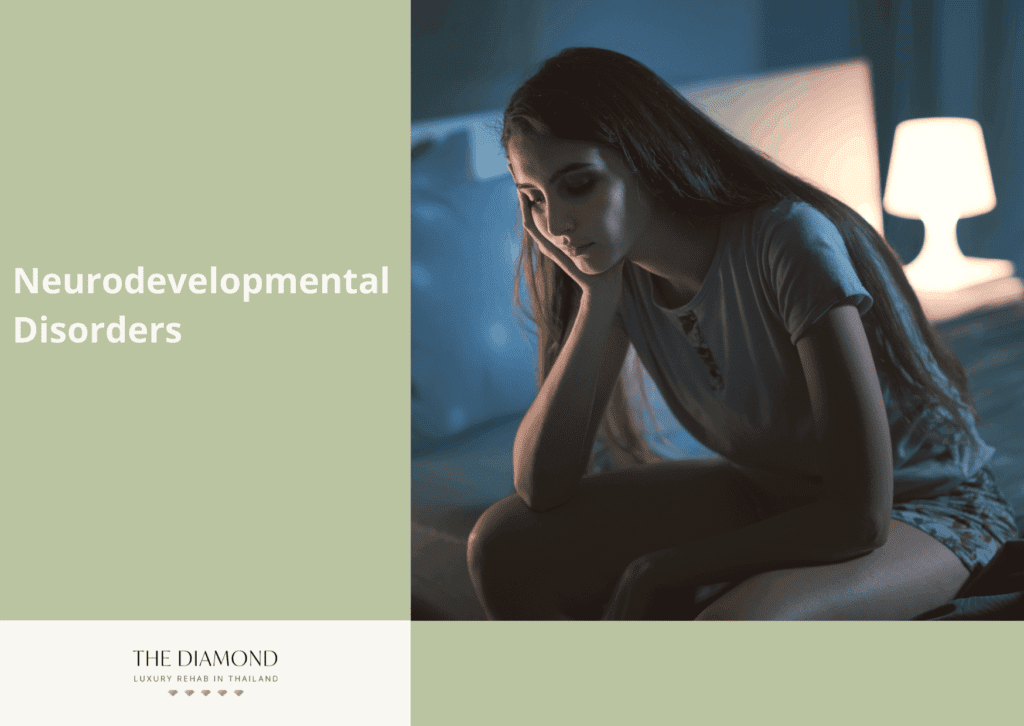
The term neurodevelopmental disorder refers to a group of mental illnesses that affect the development of the nervous system and lead to impaired brain function, which causes difficulties in social, emotional, and cognitive functioning.
The most common neurodevelopmental disorders are attention deficit hyperactivity disorder (ADHD) and autism spectrum disorders. Other neurodevelopmental disorders are intellectual disabilities, learning disorders, communication disorders, and conduct disorders.
Since these conditions tend to begin during developmental stages, they are most present in toddlers, children, and teenagers. However, they continue to be present in adulthood. In fact, numerous patients are diagnosed with a neurodevelopmental disorder in their adult years.
Symptoms of neurodevelopmental disorders are strongly dependent on the type of the condition. They usually involve problems with memory, behavior, language, speech, learning, emotions, social skills, and motor skills. These problems tend to affect a patient’s social abilities and functioning within society.
The specific cause of neurodevelopmental disorders is unclear at this point. Both biology and the environment play a role in their onset. Certain patients have genetic predispositions, trauma, stress, or illness that contributed to the formation of these disorders.
When left untreated, neurodevelopmental disorders lead to effects such as social isolation, family discord, sleep problems, difficulty forming and maintaining friendships and relationships, and difficulties living independently. With adequate treatment, children and teens with neurodevelopmental disorder are able to overcome difficulties and disabilities, but in certain situations, they are permanent.
When should a person with a mental illness see a doctor?
A person with mental illness, or an individual who suspects they have a problem with mental health, must see a doctor if they experience symptoms of psychiatric disorders. Scheduling an appointment to see a healthcare professional is particularly significant if the symptoms of mental illness are persistent and even worsen in some situations.
Individuals with untreated mental illness need to see a doctor if their condition aggravates and starts causing serious problems, a 2022 article titled, “Mental illness” from Mayo Clinic recommended.
Symptoms of mental illnesses don’t go away on their own. If not managed properly, they are likely to lead to more complications. For that reason, a person with symptoms of a mental disorder shouldn’t ignore the signs.
It’s additionally important to mention that men and women with suicidal thoughts and tendencies need to get help immediately. There are several ways to get help including contacting the emergency department, or a therapist, dialling a suicide prevention hotline number in their area and reaching out to a loved one, friend, or family member.
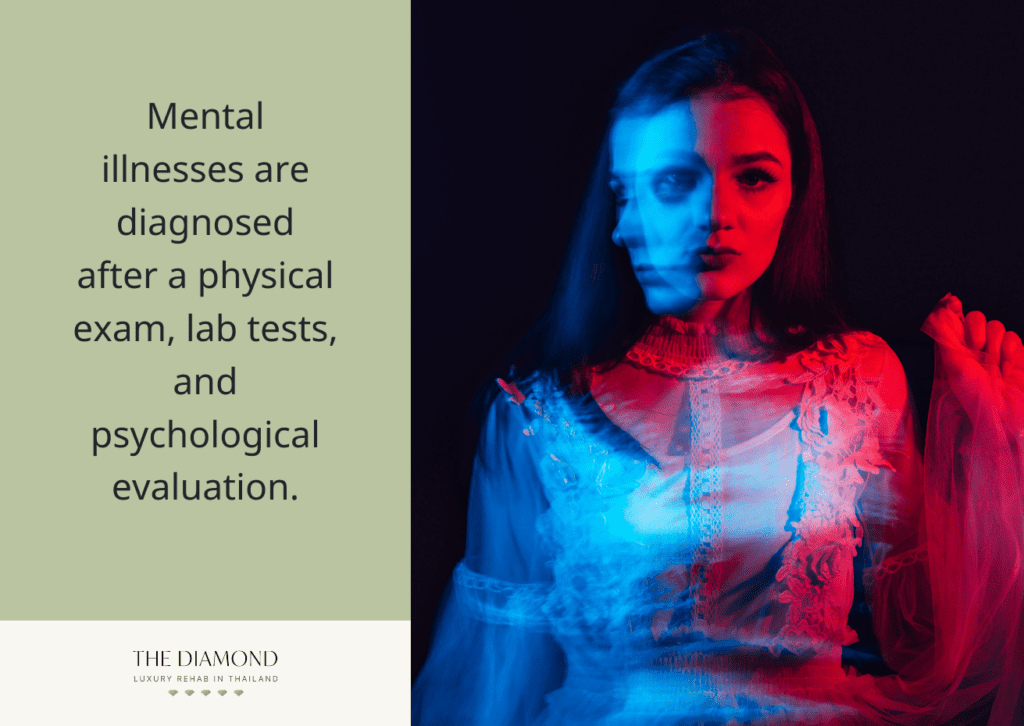
How are mental Illnesses diagnosed?
Mental illnesses are diagnosed after a physical exam, lab tests, and psychological evaluation. A healthcare provider first performs a physical exam and asks questions about symptoms. This is done to rule out physical conditions that trigger symptoms.
In addition, they are likely to order lab tests to evaluate a patient’s thyroid function or to screen for drug and alcohol abuse. Once a medical condition is ruled out, the doctor refers a patient to a mental health professional.
Finally, to confirm the diagnosis and rule out other conditions with similar symptoms, a psychological evaluation is necessary. During the psychological evaluation, patients complete a questionnaire regarding their feelings, behaviors, and thoughts.
Mental health professionals rely on DSM-5 to make an accurate diagnosis. After all, DSM-5 contains all the criteria under which a certain mental illness is diagnosed, as per an article titled, “Understanding Your Diagnosis” from the National Alliance on Mental Illness.
Upon diagnosing a mental illness, a mental health professional recommends the most suitable treatment option.
What are the available treatments for mental illness?
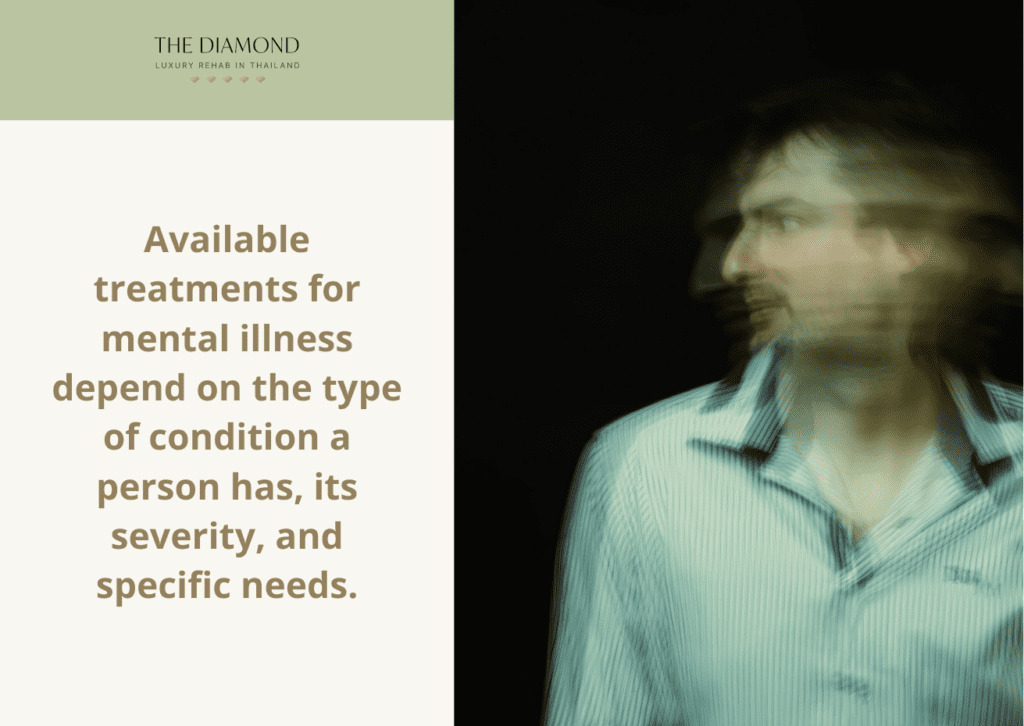
Available treatments for mental illness depend on the type of condition a person has, its severity, and specific needs. The most common mental health treatments are listed below.
- Medications: Their main purpose is to improve symptoms and reduce their intensity or frequency. Medications additionally improve the effectiveness of other treatment approaches. A mental health professional prescribes medications that are most suitable for a patient’s condition. These medications include antidepressants, anti-anxiety medications, antipsychotic medications, and mood stabilizers.
- Psychotherapy: The main objective of therapy is to help a patient understand their condition, moods, feelings, and behaviors. Certain types of therapy, such as cognitive-behavioral therapy, enable patients to identify irrational thoughts or beliefs and teach them how to correct them, which lead to more positive feelings and behaviors. During therapy sessions, patients learn coping skills, management skills, communication skills, and other skills a therapist deems necessary for the treatment of a specific mental illness. Therapy is completed within a few months, but certain patients possibly need long-term support.
- Brain-stimulation treatments: This approach is occasionally recommended for the treatment of mood disorders such as depression. Mental health professionals recommend them in cases when therapy and medications are ineffective. These treatments work by inhibiting or activating the brain with electricity to stimulate nerve cells and improve their functioning. There are several types of these treatments including vagus nerve stimulation, deep brain stimulation, electroconvulsive therapy, and repetitive transcranial magnetic stimulation.
- Addiction treatment: In various cases, mental illnesses go hand in hand with substance use disorders. For these patients, addiction treatment is necessary. When left untreated, addiction worsens the underlying mental illness. Treatment of addiction includes inpatient rehab programs as well as outpatient programs.
- Hospital and residential treatment: Recommended to patients with severe mental illnesses, especially to those who are a danger to themselves and others. This treatment helps because patients in severe conditions get medical supervision, therapy sessions, and much-needed support to get better.
Is mental illness genetic?
Yes, mental illness is genetic. In fact, a person’s family history is considered one of the major indicators for determining their likelihood of developing a mental illness. Certain psychiatric conditions tend to run in families.
That means having a close blood relative significantly increases the risk of developing a mental illness, according to a publication titled, “Looking at My Genes: What Can They Tell Me About My Mental Health?” last revised in 2020 by the National Institute on Mental Health.
A 2013 study by Smoller et al., published in The Lancet, found genetic factors in five mental health disorders. These include depression, bipolar disorder, schizophrenia, autism spectrum disorder, and ADHD.
Basically, this study found that variations of genes were present in patients with these mental illnesses. One such gene is CACNA1C which affects brain circuitry associated with emotion, memory, thinking, and attention.
Finally, a study by Pettersson et al., published in the May 2019 issue of Psychological Medicine found genetic components in eight mental illnesses, including the above mentioned five conditions, alcohol addiction, anorexia, and OCD.While genes are not the sole cause of mental illness, they play a major role in illness development.

